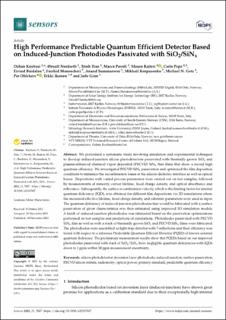| dc.contributor.author | Koybasi, Ozhan | |
| dc.contributor.author | Nordseth, Ørnulf | |
| dc.contributor.author | Tran, Trinh | |
| dc.contributor.author | Povoli, Marco | |
| dc.contributor.author | Rajteri, Mauro | |
| dc.contributor.author | Pepe, Carlo | |
| dc.contributor.author | Bardalen, Eivind | |
| dc.contributor.author | Manoocheri, Farshid | |
| dc.contributor.author | Summanwar, Anand | |
| dc.contributor.author | Korpusenko, Mikhail | |
| dc.contributor.author | Getz, Michael Norderhaug | |
| dc.contributor.author | Ohlckers, Per | |
| dc.contributor.author | Ikonen, Erkki | |
| dc.contributor.author | Gran, Jarle | |
| dc.date.accessioned | 2022-01-18T09:23:45Z | |
| dc.date.available | 2022-01-18T09:23:45Z | |
| dc.date.created | 2022-01-01T14:48:34Z | |
| dc.date.issued | 2021 | |
| dc.identifier.citation | Sensors. 2021, 21 (23), . | en_US |
| dc.identifier.issn | 1424-8220 | |
| dc.identifier.uri | https://hdl.handle.net/11250/2837830 | |
| dc.description.abstract | We performed a systematic study involving simulation and experimental techniques to develop induced-junction silicon photodetectors passivated with thermally grown SiO2 and plasma-enhanced chemical vapor deposited (PECVD) SiNx thin films that show a record high quantum efficiency. We investigated PECVD SiNx passivation and optimized the film deposition conditions to minimize the recombination losses at the silicon–dielectric interface as well as optical losses. Depositions with varied process parameters were carried out on test samples, followed by measurements of minority carrier lifetime, fixed charge density, and optical absorbance and reflectance. Subsequently, the surface recombination velocity, which is the limiting factor for internal quantum deficiency (IQD), was obtained for different film depositions via 2D simulations where the measured effective lifetime, fixed charge density, and substrate parameters were used as input. The quantum deficiency of induced-junction photodiodes that would be fabricated with a surface passivation of given characteristics was then estimated using improved 3D simulation models. A batch of induced-junction photodiodes was fabricated based on the passivation optimizations performed on test samples and predictions of simulations. Photodiodes passivated with PECVD SiNx film as well as with a stack of thermally grown SiO2 and PECVD SiNx films were fabricated. The photodiodes were assembled as light-trap detector with 7-reflections and their efficiency was tested with respect to a reference Predictable Quantum Efficient Detector (PQED) of known external quantum deficiency. The preliminary measurement results show that PQEDs based on our improved photodiodes passivated with stack of SiO2/SiNx have negligible quantum deficiencies with IQDs down to 1 ppm within 30 ppm measurement uncertainty. | en_US |
| dc.language.iso | eng | en_US |
| dc.rights | Navngivelse 4.0 Internasjonal | * |
| dc.rights.uri | http://creativecommons.org/licenses/by/4.0/deed.no | * |
| dc.title | High Performance Predictable Quantum Efficient Detector Based on Induced-Junction Photodiodes Passivated with SiO2/SiNx | en_US |
| dc.type | Peer reviewed | en_US |
| dc.type | Journal article | en_US |
| dc.description.version | publishedVersion | en_US |
| dc.source.pagenumber | 18 | en_US |
| dc.source.volume | 21 | en_US |
| dc.source.journal | Sensors | en_US |
| dc.source.issue | 23 | en_US |
| dc.identifier.doi | 10.3390/s21237807 | |
| dc.identifier.cristin | 1973253 | |
| cristin.ispublished | true | |
| cristin.fulltext | original | |
| cristin.qualitycode | 1 | |

